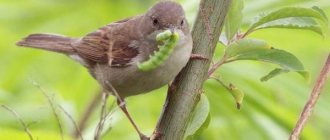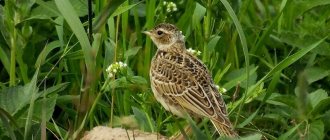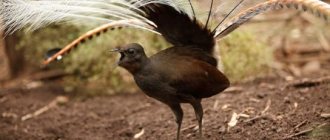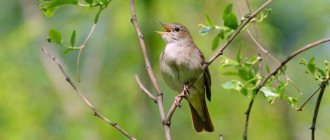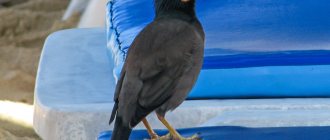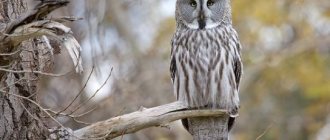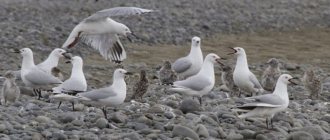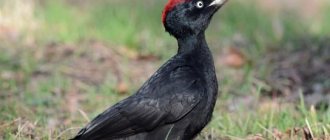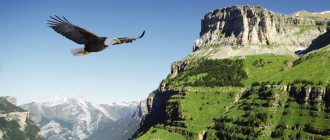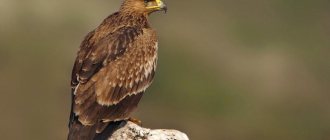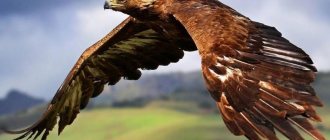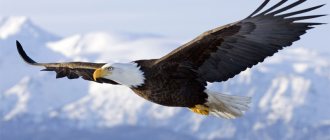| Latin name: | Neophron |
| English name: | To be confirmed |
| Kingdom: | Animals |
| Type: | Chordata |
| Class: | Birds |
| Squad: | Accipitridae |
| Family: | Accipitridae |
| Genus: | Vultures |
| Body length: | 60-70 cm |
| Wing length: | To be confirmed |
| Wingspan: | 165 cm |
| Weight: | 1500–2200 g |
What does a vulture look like?
The vulture looks like a typical scavenger. This bird does not move as actively as predators that hunt. Therefore, the vulture has weak legs and an elongated, blunt beak. The body proportions are very similar to a bearded man. The front part of the head is bald. The skin on it gathers in folds. Skin color is bright yellow or orange. The end of the beak is black. The irises of the eyes are reddish-brown.
The main color of the plumage is off-white. The feathers on the throat and chest area are yellowish. The contrasting coloring of the wings is noteworthy. The chicks are dark in color. The skin on the face of young individuals appears gray. Over time, the feathers change to lighter colors and the skin turns yellow.
Photo of a vulture
№8
In addition to the fact that they themselves are constantly looking for possible sources of food, they also regularly monitor their relatives. They rely more on other vultures to find food before they do. They monitor their behavior and if they notice suspicious movements that may indicate the discovery of food, they get closer to their relative to personally see what attracted his attention.
Where do vultures live?
Africa, its center and southern regions are the main habitat of these scavengers. They settle close to human habitations. In African settlements, flocks of vultures can be seen prowling for waste.
These birds also settle in the Mediterranean. In India you can also find a bird that eats carrion. There are populations of these birds on the Canary Islands. It will be very rare to see a pair of vultures in the Russian Federation. Several dozen of these birds live in the Caucasus. For the winter, all representatives of this species migrate to Africa. Birds are rare. Their populations are constantly decreasing.
Photo of a vulture in flight
№1
There are 23 species of vultures on our planet and at least one species is found on every continent except Australia and Antarctica. These are relatively adaptive birds that have adapted to different living conditions. However, despite their adaptability, 14 species are still endangered.
As for division, scientists divide all 23 species into representatives of the Old World (Africa, Asia and Europe), where 16 species live, and representatives of the New World (North and South America), where the remaining 7 species live.
Representatives of the Old World are different from representatives of the New World. Vultures from Europe, Africa and Asia have highly curved, eagle-like beaks. Also, their legs are more similar to those of their eagle relatives. Vultures from South and North America have weaker beaks than their Old World cousins and less developed legs.
What types of vultures are there? Their differences
In addition to the common vulture, there is a brown vulture. This species does not differ in size or lifestyle. The main difference between the brown species is the color of the plumage. Its representatives are covered with brown feathers. They do not have contrasting feathers along the edges of their wings. Solid plumage helps to hide in the savannah and African forests. The species is distributed in central Africa. These birds are also scavengers and settle near people.
Photo of a brown vulture
№2
Most species, both from the Old and New Worlds, have practically no feathers on their necks and heads. Initially, people believed that a bald head allowed them to not get so dirty after a meal, but modern scientists have a different answer to this physical feature.
Scientists have noticed that vultures stretch their necks out on hot days and tuck them under their wings in cold weather. Based on this, they came to the conclusion that a head and neck without feathers helps them regulate body temperature, since skin without feathers can quickly lose heat.
What do scavengers eat?
Birds do not disdain different types of carrion. They are eating:
- dead fish,
- insects,
- rodents,
- reptiles,
- invertebrates.
With a weak beak, they cannot tear the tough skin of ungulates. Therefore, vultures often flock to the remains of large vultures from the table. Here they get small pieces of fresh meat.
Common vultures, which live near people, search landfills for waste. They can eat human and livestock feces. Birds are not afraid of people and do not react in any way to the approach of a person. Representatives of the species do not often obtain fruit for their table. They prefer to find waste on the ground.
Scavengers consider ostrich eggs to be a delicacy. If a bird manages to find a clutch, it will not rest until it breaks the shells of all the eggs and eats its contents. To do this, the vulture finds a stone, rises into the air with it and throws it into the ostrich's nest. This is how birds use cobblestones weighing up to 500 grams.
Photo of a scavenger
№4
The largest species is the Snowy Vulture (Gyps himalayensis). It can reach a length of up to 1.5 meters, and its wingspan can be 3.1 meters. With all this, the average body weight of an adult is in the region of 8-12 kg.
The heaviest species is the Andean condor (Vultur gryphus). Its body weight can reach 15 kg.
As for the smallest representative, it is the Palm Vulture (Gypohierax angolensis). Its body length is only 60 centimeters, and its weight does not exceed 1.7 kg.
Seasonal migration
African populations lead a sedentary lifestyle. With the onset of cold weather, only birds living in Europe and Asia migrate. Birds cannot tolerate temperatures below zero. The exception is the populations that live in the mountains of Crimea and at the northern foot of the Caucasus. These birds occasionally rise to a height of 4.5 thousand meters in the mountains.
Photo of a scavenger
№9
Vultures are believed to form lifelong bonds with only one other individual. That is, they are monogamous birds. They reach sexual maturity at the age of 5-7 years (females, as usual, earlier than males). Females of larger species typically lay only one egg, while females of smaller species may lay 2 to 3 eggs. On average, a family can produce offspring once every 1-2 years. The incubation period of eggs is 38-68 days (depending on the species).
What do vulture nests look like?
Birds lead a paired lifestyle. Both parents hatch the eggs. During the breeding season, the pair builds a nest. It is often located in rocks. Having found a convenient cave, the parents bring branches there. A loose mesh is woven from them. The bottom of the nest is covered with human hair and animal hair. Frequently, debris found in a landfill can be seen in the nest structure. Often nests are located in colonies.
The female lays two eggs. This happens at the end of January. For the next 40 days, the parents take turns incubating the eggs. After the chicks hatch, they are fed for almost three months. When the young individual firmly stands on its wing, it flies away from its parental home.
Photo of a vulture
Social structure and reproduction
Photo: Pair of vultures
Outside the breeding season, vultures mostly live in small groups of a dozen or two individuals. Some live separately from groups, alone or in pairs; usually these have to wait near the prey until the flock is fed. When the season begins in mid-spring, they form pairs.
Their mating ritual is simple: males and females perform a dance - they fly up and fall down in a sharp dive, converge, putting their paws forward, so it may seem as if they are going to fight. After the end of the ritual, they build a nest or expand what was already built in previous years.
Then the female lays a clutch, most often of two eggs, white with brown spots. They are incubated alternately by both parents for six weeks. Newborn chicks are covered with white fluff, and their incubation does not end there: for the first week or two, the female is constantly in the nest, since the chicks need to be warmed.
Only when the first fluff changes to a thicker one does she begin to fly out of the nest to help the male in finding food for the chicks. As soon as they are covered with feathers, they get out of the nest and begin to actively flap their wings, but they cannot fly yet.
They fly on the wing only 11-12 weeks after hatching, but remain with their parents even after that, although for the most part they already feed on their own, flying with their parents. In the fall they begin to live independently, and fly away from cold places for the winter, where they remain until they reach sexual maturity - this happens by the age of five.
Interesting fact: The vulture's stomach produces a stronger acid than other animals, which is why they can feed on rotting meat: the acid kills all pathogens, making it harmless.
Interesting Facts
The name of the species itself comes from the Old Slavonic word “styrva” - “carrion”. In ancient India, vultures were deified, but in Europe they were treated with disgust. In the human world, vultures refer to selfish and cruel characters. In fact, birds have a calm disposition. They are not at all bloodthirsty. You can even say that they are friendly to humans.
Vultures can be called a tangle of contradictions. They are good parents, but they eat ostrich eggs without regret. They don't like fruit, but they do eat feces. The population of these amazing birds is noticeably declining from year to year. In some countries they are listed in the Red Books. In Russia, for example, there are no more than 50 pairs left.
Photo of a scavenger bird
Listen to the cry of a vulture
The audio tag is not supported by your browser. Close
№3
As mentioned at the beginning of the article, vultures have a pretty bad reputation. However, in Ancient Egypt this bird was revered. The ancient Egyptians considered vultures to be devoted mothers, so they associated them with motherhood and compassion. In addition, the Egyptians considered them the embodiment of their rulers, since they watch over everyone from above.
